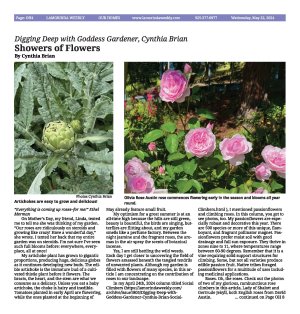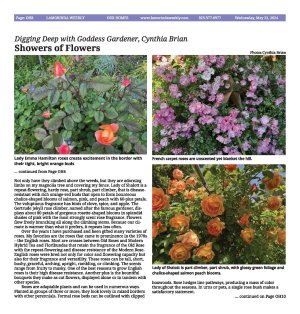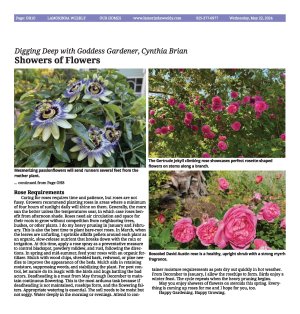|
|
Published May 22nd, 2024
|
Digging Deep with Goddess Gardener, Cynthia Brian
|
| Showers of Flowers |
| By Cynthia Brian |
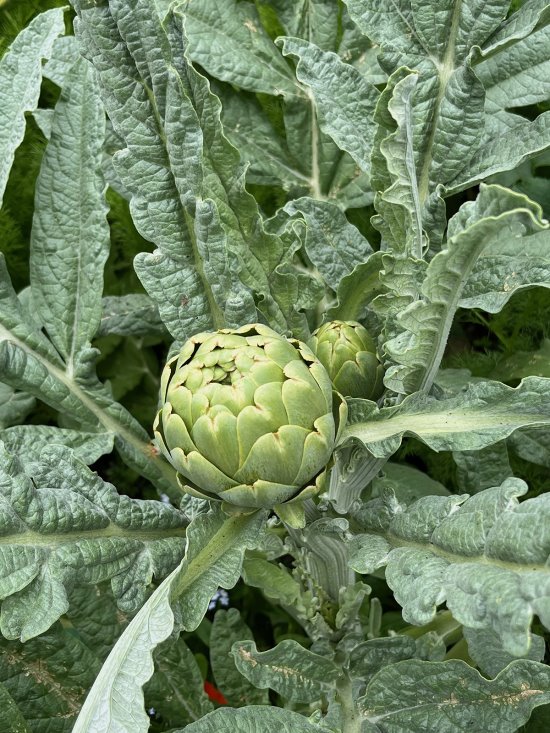 |
| Artichokes are easy to grow and delicious! Photos Cynthia Brian |
"Everything is coming up roses-for me!" Ethel Merman
 On Mother's Day, my friend, Linda, texted me to tell me she was thinking of my garden. "Our roses are ridiculously on steroids and growing like crazy! Have a wonderful day," she wrote. I texted her back that my entire garden was on steroids. I'm not sure I've seen such full blooms before: everywhere, everyplace, all at once!
On Mother's Day, my friend, Linda, texted me to tell me she was thinking of my garden. "Our roses are ridiculously on steroids and growing like crazy! Have a wonderful day," she wrote. I texted her back that my entire garden was on steroids. I'm not sure I've seen such full blooms before: everywhere, everyplace, all at once!
 My artichoke plant has grown to gigantic proportions, producing huge, delicious globes as it continues developing new buds. The edible artichoke is the immature bud of a cultivated thistle plant before it flowers. The bracts, the heart, and the stem are what we consume as a delicacy. Unless you eat a baby artichoke, the choke is hairy and inedible. Tomatoes planted in early April are flowering, while the ones planted at the beginning of May already feature small fruit.
My artichoke plant has grown to gigantic proportions, producing huge, delicious globes as it continues developing new buds. The edible artichoke is the immature bud of a cultivated thistle plant before it flowers. The bracts, the heart, and the stem are what we consume as a delicacy. Unless you eat a baby artichoke, the choke is hairy and inedible. Tomatoes planted in early April are flowering, while the ones planted at the beginning of May already feature small fruit.
 My optimism for a great summer is at an all-time high because the hills are still green, beauty is bountiful, the birds are singing, butterflies are flitting about, and my garden smells like a perfume factory. Between the night jasmine and the fragrant roses, the aromas in the air spray the scents of botanical incense.
My optimism for a great summer is at an all-time high because the hills are still green, beauty is bountiful, the birds are singing, butterflies are flitting about, and my garden smells like a perfume factory. Between the night jasmine and the fragrant roses, the aromas in the air spray the scents of botanical incense.
 Yes, I am still battling the wild weeds. Each day I get closer to uncovering the field of flowers amassed beneath the tangled tendrils of unwanted plants. Although my garden is filled with flowers of many species, in this article I am concentrating on the contribution of roses to our landscape.
Yes, I am still battling the wild weeds. Each day I get closer to uncovering the field of flowers amassed beneath the tangled tendrils of unwanted plants. Although my garden is filled with flowers of many species, in this article I am concentrating on the contribution of roses to our landscape.
 In my April 24th, 2024 column titled Social Climbers (https://lamorindaweekly.com/
In my April 24th, 2024 column titled Social Climbers (https://lamorindaweekly.com/
 archive/issue1805/Digging-Deep-with-Goddess-Gardener-Cynthia-Brian-Social-Climbers.html ), I mentioned passionflowers and climbing roses. In this column, you get to see photos, too. My passionflowers are especially robust and decorative this year. There are 500 species or more of this unique, flamboyant, and fragrant pollinator magnet. Passionflowers prefer moist soil with good drainage and full sun exposure. They thrive in zones nine to 11, where temperatures range between 60-90 degrees. Remember that it is a vine requiring solid support structures for climbing. Some, but not all varieties produce edible passion fruit. Native tribes foraged passionflowers for a multitude of uses including medicinal applications.
archive/issue1805/Digging-Deep-with-Goddess-Gardener-Cynthia-Brian-Social-Climbers.html ), I mentioned passionflowers and climbing roses. In this column, you get to see photos, too. My passionflowers are especially robust and decorative this year. There are 500 species or more of this unique, flamboyant, and fragrant pollinator magnet. Passionflowers prefer moist soil with good drainage and full sun exposure. They thrive in zones nine to 11, where temperatures range between 60-90 degrees. Remember that it is a vine requiring solid support structures for climbing. Some, but not all varieties produce edible passion fruit. Native tribes foraged passionflowers for a multitude of uses including medicinal applications.
 Roses. Oh, the roses. Check out the photos of two of my glorious, rambunctious rose climbers in this article, Lady of Shalott and Gertrude Jekyll, both English roses from David Austin. Not only have they climbed above the weeds, but they are adorning limbs on my magnolia tree and covering my fence. Lady of Shalott is a repeat-flowering, hardy rose, part shrub, part climber, that is disease-resistant with rich orange-red buds that open to form bounteous chalice-shaped blooms of salmon, pink, and peach with 60-plus petals. The voluptuous fragrance has hints of clove, spice, and apple. The Gertrude Jekyll rose climber, named after the famous gardener, displays about 80 petals of gorgeous rosette-shaped blooms in splendid shades of pink with the most strongly scent rose fragrance. Flowers flow freely branching all along the climbing stems. Because our climate is warmer than what it prefers, it repeats less often.
Roses. Oh, the roses. Check out the photos of two of my glorious, rambunctious rose climbers in this article, Lady of Shalott and Gertrude Jekyll, both English roses from David Austin. Not only have they climbed above the weeds, but they are adorning limbs on my magnolia tree and covering my fence. Lady of Shalott is a repeat-flowering, hardy rose, part shrub, part climber, that is disease-resistant with rich orange-red buds that open to form bounteous chalice-shaped blooms of salmon, pink, and peach with 60-plus petals. The voluptuous fragrance has hints of clove, spice, and apple. The Gertrude Jekyll rose climber, named after the famous gardener, displays about 80 petals of gorgeous rosette-shaped blooms in splendid shades of pink with the most strongly scent rose fragrance. Flowers flow freely branching all along the climbing stems. Because our climate is warmer than what it prefers, it repeats less often.
 Over the years I have purchased and been gifted many varieties of roses. My favorites are the roses that came to prominence in the 1970s - the English roses. Most are crosses between Old Roses and Modern Hybrid Tea and Floribundas that retain the fragrance of the Old Rose with the repeat-flowering and disease resistance of the Modern Rose. English roses were bred not only for color and flowering capacity but also for their fragrance and versatility. These roses can be tall, short, bushy, graceful, arching, upright, rambling, or climbing. The scents range from fruity to musky. One of the best reasons to grow English roses is their high disease resistance. Another plus is the bountiful bouquets they make as cut flowers, displayed alone or in tandem with other species.
Over the years I have purchased and been gifted many varieties of roses. My favorites are the roses that came to prominence in the 1970s - the English roses. Most are crosses between Old Roses and Modern Hybrid Tea and Floribundas that retain the fragrance of the Old Rose with the repeat-flowering and disease resistance of the Modern Rose. English roses were bred not only for color and flowering capacity but also for their fragrance and versatility. These roses can be tall, short, bushy, graceful, arching, upright, rambling, or climbing. The scents range from fruity to musky. One of the best reasons to grow English roses is their high disease resistance. Another plus is the bountiful bouquets they make as cut flowers, displayed alone or in tandem with other species.
 Roses are adaptable plants and can be used in numerous ways. Planted in groups of three or more, they look lovely in mixed borders with other perennials. Formal rose beds can be outlined with clipped boxwoods. Rose hedges line pathways, producing a mass of color throughout the seasons. In urns or pots, a single rose bush makes a satisfactory statement.
Roses are adaptable plants and can be used in numerous ways. Planted in groups of three or more, they look lovely in mixed borders with other perennials. Formal rose beds can be outlined with clipped boxwoods. Rose hedges line pathways, producing a mass of color throughout the seasons. In urns or pots, a single rose bush makes a satisfactory statement.
 Rose Requirements
Rose Requirements
 Caring for roses requires time and patience, but roses are not fussy. Growers recommend planting roses in areas where a minimum of four hours of sunlight daily will shine on them. Generally, the more sun the better unless the temperatures soar, in which case roses benefit from afternoon shade. Roses need air circulation and space for their roots to grow without competition from neighboring trees, bushes, or other plants. I do my heavy pruning in January and February. This is also the best time to plant bare-root roses. In March, when the leaves are unfurling, I sprinkle alfalfa pellets around each plant as an organic, slow-release nutrient that breaks down with the rain or irrigation. At this time, apply a rose spray as a preventative measure to control blackspot, powdery mildew, and rust, following the directions. In spring and mid-summer, feed your roses with an organic fertilizer. Mulch with wood chips, shredded bark, redwood, or pine needles to improve the appearance of the beds. Mulch aids in retaining moisture, suppressing weeds, and stabilizing the plant. For pest control, let nature do its magic with the birds and bugs battling the bad actors. Deadheading is a must from May through December to maintain continuous flowering. This is the most arduous task because if deadheading is not maintained, rosehips form, and the flowering falters. Appropriate watering is essential. The soil needs to be moist but not soggy. Water deeply in the morning or evenings. Attend to container moisture requirements as pots dry out quickly in hot weather. From December to January, I allow the rosehips to form. Birds enjoy a winter feast. The cycle repeats when the heavy pruning begins.
Caring for roses requires time and patience, but roses are not fussy. Growers recommend planting roses in areas where a minimum of four hours of sunlight daily will shine on them. Generally, the more sun the better unless the temperatures soar, in which case roses benefit from afternoon shade. Roses need air circulation and space for their roots to grow without competition from neighboring trees, bushes, or other plants. I do my heavy pruning in January and February. This is also the best time to plant bare-root roses. In March, when the leaves are unfurling, I sprinkle alfalfa pellets around each plant as an organic, slow-release nutrient that breaks down with the rain or irrigation. At this time, apply a rose spray as a preventative measure to control blackspot, powdery mildew, and rust, following the directions. In spring and mid-summer, feed your roses with an organic fertilizer. Mulch with wood chips, shredded bark, redwood, or pine needles to improve the appearance of the beds. Mulch aids in retaining moisture, suppressing weeds, and stabilizing the plant. For pest control, let nature do its magic with the birds and bugs battling the bad actors. Deadheading is a must from May through December to maintain continuous flowering. This is the most arduous task because if deadheading is not maintained, rosehips form, and the flowering falters. Appropriate watering is essential. The soil needs to be moist but not soggy. Water deeply in the morning or evenings. Attend to container moisture requirements as pots dry out quickly in hot weather. From December to January, I allow the rosehips to form. Birds enjoy a winter feast. The cycle repeats when the heavy pruning begins.
 May you enjoy showers of flowers on steroids this spring. Everything is coming up roses for me and I hope for you, too.
May you enjoy showers of flowers on steroids this spring. Everything is coming up roses for me and I hope for you, too.
 Happy Gardening. Happy Growing.
Happy Gardening. Happy Growing. |
 |
| Olivia Rose Austin rose commences flowering early in the season and blooms all year round. Photos Cynthia Brian |
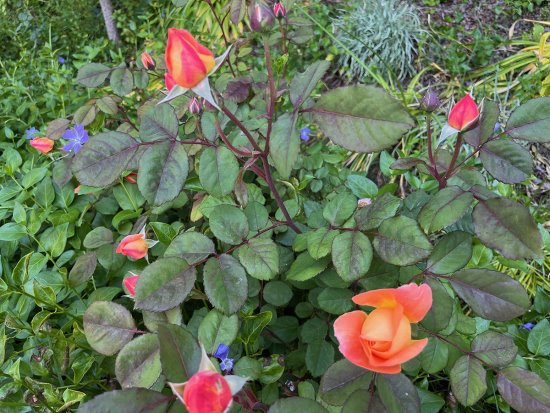 |
| Lady Emma Hamilton roses create excitement in the border with their tight, bright orange buds Photos Cynthia Brian |
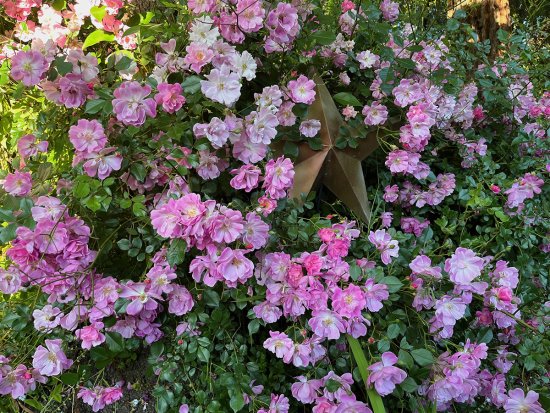 |
| French carpet roses are unscented yet blanket the hill. Photos Cynthia Brian |
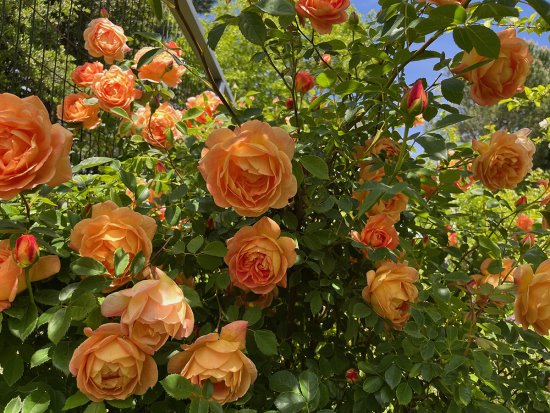 |
| Lady of Shalott is part climber, part shrub, with glossy green foliage and chalice-shaped salmon peach blooms. Photos Cynthia Brian |
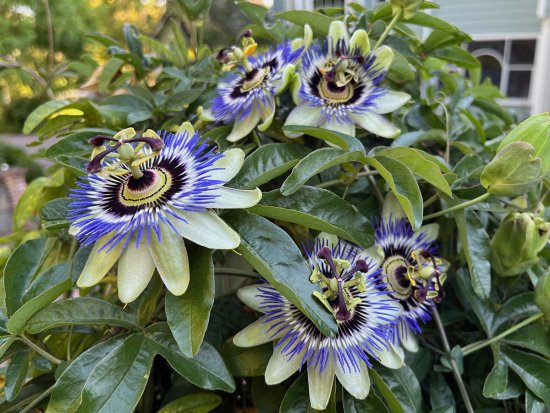 |
| Mesmerizing passionflowers will send runners several feet from the
mother plant. |
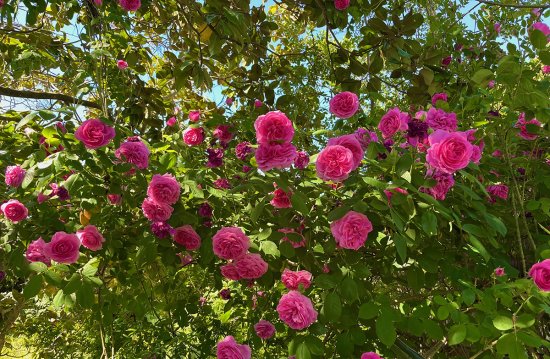 |
| The Gertrude Jekyll climbing rose showcases perfect rosette-shaped
flowers on stems along a branch. |
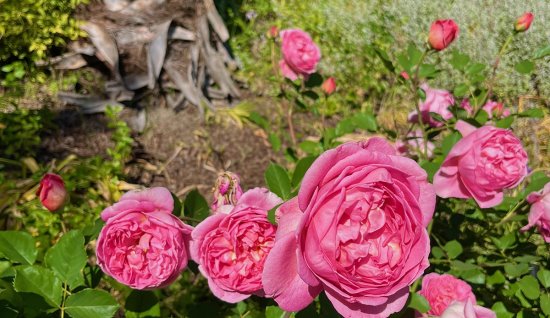 |
| Boscobel David Austin rose is a healthy, upright shrub with a
strong myrrh fragrance. |
 |
Cynthia Brian inhales scents of Huntington rose and jasmine!
For more gardening advice for all seasons, check out Growing with the Goddess Gardener at
https://www.CynthiaBrian.com/books. Raised in the vineyards of Napa County, Cynthia Brian is a New York Times best-selling author, actor, radio personality, speaker, media and writing coach as well as the Founder and Executive Director of Be the Star You Are!r 501 c3 which was just honored as the 2024 Nonprofit of the Year by the Moraga Chamber of Commerce. Tune into Cynthia's StarStyler Radio Broadcast at
www.StarStyleRadio.com. Her newest children's picture book, Books in the Barnyard: Oh Deer!, from the series, Stella Bella's Barnyard Adventures is available for discounted pre-sales at
https://www.CynthiaBrian.com/online-store. Hire Cynthia for writing projects, garden consults, and inspirational lectures.
Cynthia@GoddessGardener.com
https://www.CynthiaBrian.com |
|
|
|










